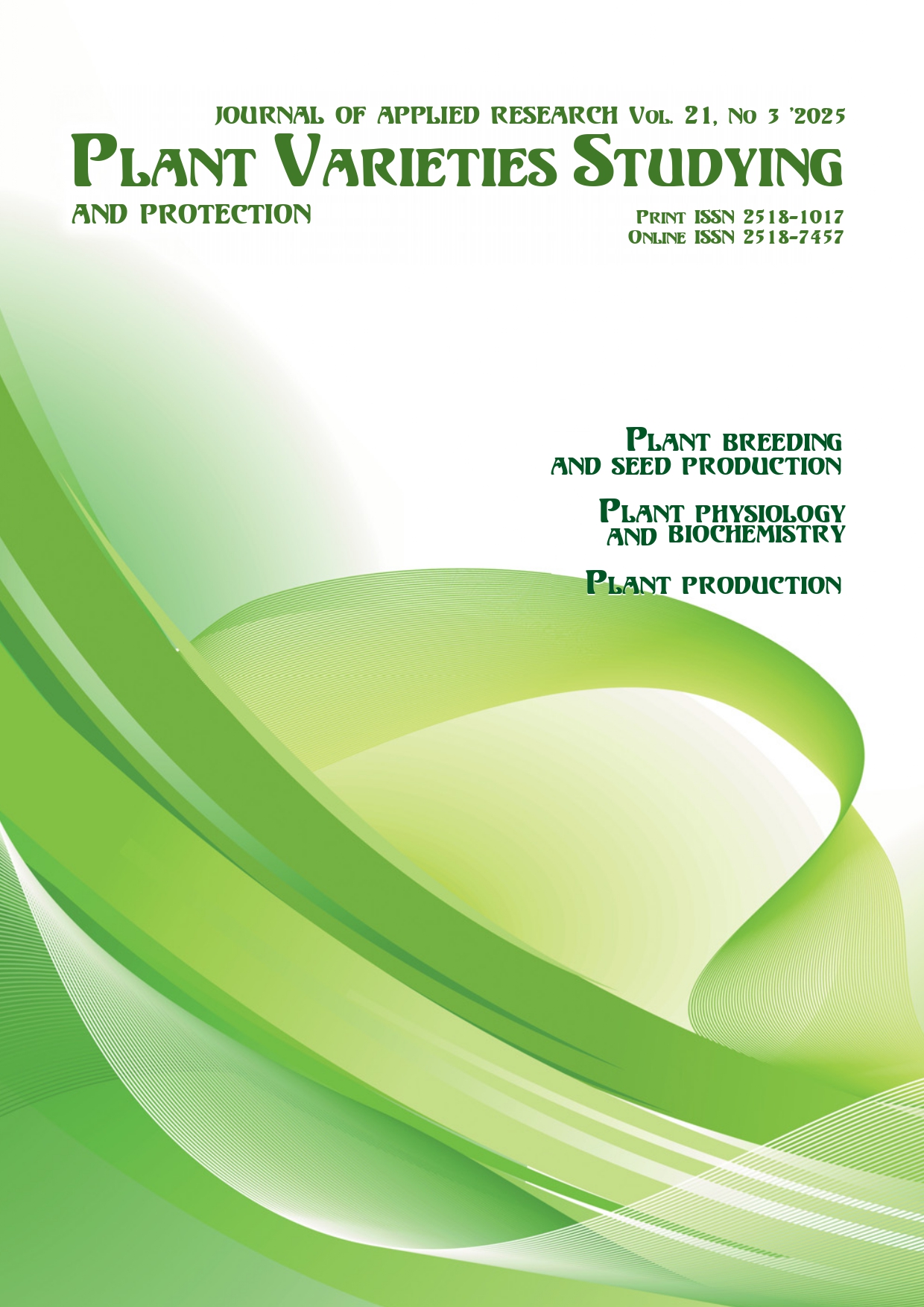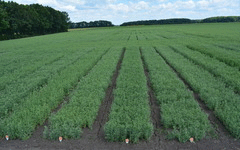Peculiarities of morphogenesis in lavender and lavandin grown on hormone-free medium under in vitro culture conditions
DOI:
https://doi.org/10.21498/2518-1017.21.3.2025.339318Keywords:
Lavandula angustifolia Mill., Lavandula × intermedia Emeric ex Loisel., explants, in vitro, cultivationAbstract
Purpose. To determine the biometric parameters of lavender (Lavandula angustifolia Mill.) and lavandin (Lavandula × intermedia Emeric ex Loisel.) varieties grown in vitro using three types of explant on a nutrient medium without growth regulators. Methods. The study employed clonal micropropagation using micro-shoot tips and stem segments containing one or two internodes. Lavender (‘Hidcote Blue’ and ‘Mriia’) and lavandin (‘Platinum Nico’ and ‘Edelweiss’) varieties were cultivated on a hormone-free Murashige-Skoog medium at a temperature of 23 ± 2 °C, with a photoperiod of 16/8 hours and a light intensity of 3000 lux. After one month of cultivation, the propagation coefficient, regeneration potential, number of internodes and height of micro-shoots were calculated. Dispersion-correlation analysis was performed on the obtained data using the computer programs ANOVA and MS Excel. Results. The highest reproduction coefficient was found in plants regenerated on stem segments with two internodes: 1.3–1.5 shoots per explant for L. angustifolia and 1.9–2.0 for Lavandula × intermedia. The maximum height of micro-shoots was observed in lavender and lavandin development from apical explants in a medium without cytokinins, in which apical dominance was maintained. For L. angustifolia varieties, this indicator was similar at 3.1–3.2 cm (due in part to shorter internodes compared to lavandin). However, for Lavandula × intermedia, it varied significantly due to genetic characteristics and explant type: 3.5 cm for ‘Platinum Nico’ versus 10.6 cm for ‘Edelweiss’ (the maximum value). The largest number of internodes formed on the apical explants. There were no significant differences in the number of internodes found in lavender varieties, ranging from 2.4 to 2.6 pieces. However, in lavandin, the difference was significant, ranging from 2.6 pieces in the ‘Platinum Nico’ cultivar to 3.8 pieces in the ‘Edelweiss’ cultivar. The maximum value of 4.4 was recorded in the ‘Edelweiss’ cultivar on stem segments with two internodes. The regeneration potential of apical explants was 100% for all varieties studied, compared to 60% and 70% for single- and double-node explants, respectively, in lavender ‘Hidcote Blue’, and 80% and 90% in lavandin ‘Edelweiss’. Conclusions. The possibility of propagating the studied varieties on a nutrient medium that does not contain growth regulators was demonstrated. Biometric indicators under these cultivation conditions are slightly lower or the same as those obtained on hormonal media. The analysed parameters were found to depend significantly on the type of initial explants and the varietal characteristics of lavender and lavandin.
Downloads
References
State register of plant varieties suitable for propagation in Ukraine 2025 (the register is valid as of July 16, 2025). https://minagro.gov.ua/file-storage/reyestr-sortiv-roslin [In Ukrainian]
Wells, R., Truong, F., Adal, M., Sarker, L. S., & Mahmoud, S. S. (2018). Lavandula essential oils: current review of applications in medicinal, food, and cosmetic industries of lavender. Natural Product Communications, 13(10), 1403‒1417. https://doi.org/10.1177/1934578x1801301038

Crişan, I., Ona, A., Vărban, D., Muntean, L., Vărban, R., Stoie, A., Mihăiescu, T., & Morea, A. (2023). Current trends for lavender (Lavandula angustifolia Mill.) crops and products with emphasis on essential oil quality. Plants, 12(2), Article 357. https://doi.org/10.3390/plants12020357
 |
| 
Pokajewicz, K., Białoń, M., Svydenko, L., Hudz, N., Balwicrz, R., Marciniak, D., & Wieczorek, P. (2022). Comparative Evaluation of the Essential Oil of the New Ukrainian Lavandula angustifolia and Lavandula × intermedia Cultivars Grown on the Same Plots. Molecules, 27(7), Article 2152. https://doi.org/10.3390/molecules27072152
 |
| 
Svidenko, L., & Stetsenko, I. (2020). Comparative assessment of morphometric features and agronomic characteristics of Lavandula angustifolia mill. and Lavandula hybrida rev. Scientific Horizons, 87(2), 24–31. https://doi.org/10.33249/2663-2144-2020-87-02-24-31 [In Ukrainian]

Koefender, J., Manfio, C. E., Camera, J. N., Schoffel, A., & Golle, D. P. (2021). Micropropagation of lavender: a protocol for production of plantlets. Horticultura Brasileira, 39(4), 404–410. https://doi.org/10.1590/s0102-0536-20210409

Rodrigues, D. B, Radke, A. K, Sommer, L. R, Rosa, D. S. B, Schuch, M. W., & Assis, A.M. (2020). Quality of light and indolbutyric acid in vitro rooting of lavender. Ornamental Horticulture, 26(1), 89–94. https://doi.org/10.1590/2447-536x.v26i1.2112

Kara, N., & Baydar, H. (2020). The floral and scent characteristics of Lavandin from the micropropagation and cutting propagation. Field Сrops, 25(2), 114–121. https://doi.org/10.17557/tjfc.831884

Miclea, I., Suhani, A., Zahan, M., & Bunea, A. (2020). Effect of jasmonic acid and salicylic acid on growth and biochemical composition of in vitro – propagated Lavandula angustifolia Mill. Agronomy, 10(11), Article 1722. https://doi.org/10.3390/agronomy10111722

Gubišová, M., & Čičová, I. (2023). Multiplication of Lavender (L. angustifolia) and Lavandin (Lavandula × intermedia) in explant culture. Agriculture (Pol'nohspodarstvo), 69(1), 1–12. https://doi.org/10.2478/agri-2023-0001

Gonçalves, S., & Romano, A. (2013). In vitro culture of lavenders (Lavandula spp.) and the production of secondary metabolites. Biotechnology Advances, 31(2), 166–174. https://doi.org/10.1016/j.biotechadv.2012.09.006
 |
| 
Kara, N., & Baydar, H. (2012). Effect of different explant sources on micropropagation in lavender (Lavandula spp.). Journal of Essential Oil Bearing Plants, 15(2), 250–255. https://doi.org/10.1080/0972060X.2012.10644043

Erland, L. A. E., & Mahmoud, S. S. (2014). An efficient method for regeneration of lavandin (Lavandula × intermedia var. Crosso). In vitro Cellular and Developmental Biology Plant, 50(5), 646–654. https://doi.org/10.1007/s11627-014-9614-4

Egorova, K. S., & Ananikov, V. P. (2018). Fundamental importance of ionic interactions in the liquid phase: A review of recent studies of ionic liquids in biomedical and pharmaceutical applications. Journal of Molecular Liquids, 272, 271–300. https://doi.org/10.1016/j.molliq.2018.09.025

Amankwaah, V., Ntorinkansah, N., & Osei, G. (2025). Evaluation of media protocols for in vitro propagation of an improved variety and two landraces of Dioscorea rotundata. In vitro Cellular and Developmental Biology Plant, 61(3), 646–657. https://doi.org/10.1007/s11627-024-10504-2

Shahriyar, S., Akram, S., Khan, K., Faruk, M., & Sarkar, M. (2015). In vitro plant regeneration of potato (Solanum tuberosum L.) at the rate of different hormonal concentration. Asian Journal of Medical and Biological Research, 1(2), 297–303. https://doi.org/10.3329/ajmbr.v1i2.25625
Ehorova, N. A. (2002). Micropropagation of lavender in vitro. Bulletin of Kharkiv National Agrarian University. Series: Biology, 9(1), 65–71. [In Ukrainian]

Mohapatra, P., Ray, A., Sandeep, I. S., Parida, R., & Mohanty, S. (2021). Genetic and biochemical stability of in vitro raised and conventionally propagated Centella asiatica – A valuable medicinal herb. South African Journal of Botany, 140, 444–453, https://doi.org/10.1016/j.sajb.2021.01.004

Kour, B., Kour, G., Kaul, S., & Dhar, M. K. (2014). In vitro mass multiplication and assessment of genetic stability of in vitro raised Artemisia absinthium L. plants using ISSR and SSAP molecular markers. Advances in Botany, 2014, 1–7. https://doi.org/10.1155/2014/727020
Rudnyk-Ivashchenko, O. I., & Kremenchuk, R. I. (2019). Methods of creating new Lavandula angustifolia cultivars. Horticulture, 74, 65–72. https://doi.org/10.35205/0558-1125-2019-74-65-72 [In Ukrainian]
Murashige, T., & Skoog, F. (1962). A revised medium for rapid growth and bioassays with tobacco tissue cultures. Physiologia Plantarum, 15, 473–497. https://doi.org/10.1111/j.1399-3054.1962.tb08052.x

Downloads
Published
How to Cite
Issue
Section
License
Copyright (c) 2025 T. V. Medvedieva, T. A. Natalchuk, O. I. Rudnyk-Ivashchenko

This work is licensed under a Creative Commons Attribution-ShareAlike 4.0 International License.
Starting in 2022, the copyright to the publication remains with the authors
Our journal abides by the CREATIVE COMMONS copyright rights and permissions for open access journals.
Authors, who are published in this journal, agree to the following conditions:
- The authors reserve the right to authorship of the work and pass the first publication right of this work to the journal under the terms of a Creative Commons Attribution License, which allows others to freely distribute the published research with the obligatory reference to the authors of the original work and the first publication of the work in this journal.
- The authors have the right to conclude separate supplement agreements that relate to non-exclusive work distribution in the form in which it has been published by the journal (for example, to upload the work to the online storage of the journal or publish it as part of a monograph), provided that the reference to the first publication of the work in this journal is included.

























 Ukrainian Institute for Plant Varieties Examination
Ukrainian Institute for Plant Varieties Examination  Селекційно-генетичний інститут
Селекційно-генетичний інститут Institute of Plant Physiology and Genetics of the National Academy of Sciences of Ukraine
Institute of Plant Physiology and Genetics of the National Academy of Sciences of Ukraine
 The National Academy of Agrarian Sciences of Ukraine
The National Academy of Agrarian Sciences of Ukraine